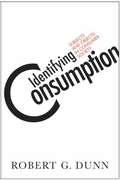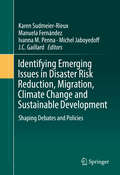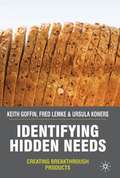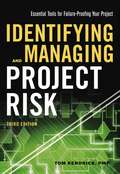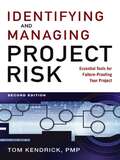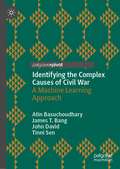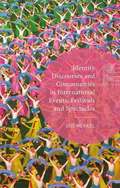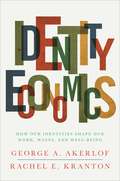- Table View
- List View
Identify Strategic Positions: Which Jobs Are the Most Critical to Your Firm's Strategic Success?
by Richard W. Beatty Brian E. Becker Mark A. HuselidClarifying your firm's strategy and the strategic capabilities needed to execute it is a crucial first step in the process of developing a differentiated workforce. The next step in the process is to identify the strategic jobs essential for delivering the firm's strategic capabilities, as well as the specific employee competencies and behaviors needed in these roles. This chapter addresses the differences between the authors' differentiated approach and conventional approaches to job design and shows why managers must understand which jobs have the greatest strategic impact. This chapter was originally published as chapter 3 of "The Differentiated Workforce: Transforming Talent into Strategic Impact."
Identify Your Preferences: Generation Y--Shaping Your Personal Career Strategy
by Tamara EricksonThere is a clear link between understanding what you love and identifying tangible elements of the work environment that would be best for you. What is the deciding factor in your job search? In this chapter, the author describes six archetypes of work-related passions and preferred relationships. She also includes an exercise to help you determine which of the six rates highest for you.
Identify the Industries--1996
by William J. Bruns Jr. Jeremy Cott Sharon M. MckinnonCommon-size balance sheets and financial ratios are given for thirteen companies. Students must identify which company is in which of thirteen industries. Gives students practice in using financial ratios and exploring financial characteristics of companies and industries.
Identify the Industries--1996
by William J. Bruns Jr. Jeremy Cott Sharon M. McKinnonCommon-size balance sheets and financial ratios are given for thirteen companies. Students must identify which company is in which of thirteen industries. Gives students practice in using financial ratios and exploring financial characteristics of companies and industries.
Identify the Nonprofit
by Regina E. Herzlinger Ramona K. HilgenkampThis case presents financial statements and selected ratios for seven unidentified nonprofit organizations and asks that each set of financial information be matched with one of the following nonprofit entities: a public television station, a suburban hospital, a metropolitan art museum, a health insurer, a municipal government, a social service organization, and a private college.
Identifying Consumption: Subjects and Objects in Consumer Society
by Robert G. DunnIdentifying Consumption illustrates how an individual's buying habits are shaped by the dynamics of the consumer marketplace--and thus how consumption and identity inform each other. Robert Dunn brings together the various theories of spending and develops a mode of analysis concentrating on the individual subjectivity of consumption. By doing so, he addresses how we spend and its relationship with status and lifestyle. Dunn provides a comprehensive guide to the study of modern consumer behavior before summarizing and critiquing the major theories of consumption. At this juncture, he proposes a method of analysis that focuses on the significance of status and lifestyle in social relations that can help explain how the consumer marketplace is shaped. He concludes by raising issues about different ways of consuming and the relationship between consumption and identity.
Identifying Emerging Issues in Disaster Risk Reduction, Migration, Climate Change and Sustainable Development
by Karen Sudmeier-Rieux Manuela Fernández Ivanna M. Penna Michel Jaboyedoff J. C. GaillardThe proposed book is a timely contribution to researchers, students, scholars and policy makers in the fields of environment, human geography, development and disaster studies towards providing a more comprehensive grasp of contemporary development issues. Contributions include well-known practitioners and scientists that provide theoretical discussions as well as field observations regarding climate change adaptation, migration, disaster risk reduction and sustainable development linkages from around the world. One of the main barriers to furthering our understanding about the inter-linkages between these forces of development (or lack thereof) is the silo approach with which we address such issues. In spite of political talk about how to bridge gaps between climate change adaptation and disaster risk reduction, institutional architectures and frameworks maintain the divisions. The goal of this book is to explore these inter-linkages from a number of different geographical, social and natural science angles and contribute to the debate about how to improve disaster risk reduction (DRR) policies and practices, taking into account migration process from a large perspective where both natural and social factors are crucial and mutually "alloyed".
Identifying Firm Capital Structure
by Bo BeckerStudents are asked to link concealed balance sheets with firm descriptions. The case helps students understand how balance sheets reflect industry and firm characteristics.
Identifying Hidden Needs: Creating Breakthrough Products
by Keith Goffin Fred Lemke Ursula KonersToo many new products fail. New products which are hard to differentiate from existing products won't capture the customer's imagination. The failure is due to a poor understanding of customers' needs. Companies need to take a radical approach to identifying customers' real needs, and this book demonstrates innovative ways to achieve this.
Identifying Jobs to Be Done: Uncovering New Routes for Growth
by Scott D. Anthony John A. Quelch Mark W. Johnson Joseph V. Sinfield Elizabeth J. Altman Lisa D. DonovanTo identify opportunities to create new growth, look first for important "jobs" that customers can't get done satisfactorily with current solutions. Embracing this notion of customers "hiring" products and services to get jobs done in their lives can help companies master the innovation life cycle.
Identifying Market Opportunities in Ten Great Divides: How Social Entrepreneurs Are Creating the Markets of the Future
by John Elkington Pamela HartiganIn this chapter, the authors look at the ten great divides between the fortunate and the not-so-fortunate to emerge from the UN's Millennium Development Goals-including demographics, finance, health and the environment-as pointers to tomorrow's market opportunities. They outline the relevant challenges of each divide and sketch some of the ways that social and environmental entrepreneurs are working to address them.
Identifying Nonconsumers: Uncovering New Routes for Growth
by Scott D. Anthony Mark W. Johnson Joseph V. Sinfield Elizabeth J. AltmanFinding ways to connect with nonconsumers is one of the best methods for internal innovators to position disruption as an opportunity instead of a threat. This chapter describes how to identify specific constraints on consumption, and how to begin conceptualizing ideas to reach nonconsumers.
Identifying Overshot Customers: Uncovering New Routes for Growth
by Scott D. Anthony Mark W. Johnson Joseph V. Sinfield Elizabeth J. AltmanAt the heart of the disruptive innovation model is the concept of overshooting, that is, providing too much performance for a given group of customers. This chapter describes overshooting in detail, laying out the strategic choices an incumbent and an entrant face when overshooting occurs.
Identifying and Developing Capable Leaders
by Clayton M. ChristensenPresents a synopsis of High Flyers, by Morgan McCall. Offers a method for identifying and training managers with potential--to build management bench strength.
Identifying and Exploiting the Right Entrepreneurial Opportunity...For You
by Howard H. Stevenson Shirley M. SpenceThis note provides an analytical framework for assessing potential opportunities in the context of an entrepreneur's life. The framework has two parts -- a business analysis and a personal analysis -- each comprised of a set of yes/no questions for critical assessment criteria. The note also offers perspectives on entrepreneurship, observations about combining an entrepreneurial career with your personal life, and comments about the pursuit of opportunities in general.
Identifying and Managing Project Risk 4th Edition: Essential Tools for Failure-Proofing Your Project
by Tom KendrickThe most essential component of every project manager&’s job is the ability to identify potential risks before they cause unnecessary headaches and turmoil all around.All projects are inherently risky, and complex ones can potentially be the downfall for even the most experienced project manager. From technical challenges and resource issues to unrealistic deadlines and problems with your subcontractors, any number of things can go wrong.Fully updated, consistent with PMI® standards, and addressing &“VUCA&” (Volatility, Uncertainty, Complexity, and Ambiguity—the now-common business and project management acronym), this book remains the definitive resource for project managers seeking to be proactive in their efforts to guard against failure and minimize unwanted surprises.Identifying and Managing Project Risk draws on real-world situations and hundreds of risk examples to show you how to:Thoroughly discover and document risksUse risk assessment techniques effectivelyImplement a system for monitoring and controlling projectsPersonalize proven methods for project risk management on any type of projectComplete with fresh guidance on program risk management, qualitative and quantitative risk analysis, simulation and modeling, and significant &“non-project&” risks, this one-stop indispensable resource is what every project manager needs to avoid chaos and keep their projects on track.
Identifying and Managing Project Risk: Essential Tools for Failure-Proofing Your Project
by Tom KendrickWinner of the Project Management Institute's David I. Cleland Project Management Literature Award 2010 It's no wonder that project managers spend so much time focusing their attention on risk identification. Important projects tend to be time constrained, pose huge technical challenges, and suffer from a lack of adequate resources. Identifying and Managing Project Risk, now updated and consistent with the very latest Project Management Body of Knowledge (PMBOK)® Guide, takes readers through every phase of a project, showing them how to consider the possible risks involved at every point in the process. Drawing on real-world situations and hundreds of examples, the book outlines proven methods, demonstrating key ideas for project risk planning and showing how to use high-level risk assessment tools. Analyzing aspectssuch as available resources, project scope, and scheduling, this new edition also explores the growing area of Enterprise Risk Management. Comprehensive and completely up-to-date, this book helps readers determine risk factors thoroughly and decisively. . . before a project gets derailed.
Identifying and Managing Project Risk: Essential Tools for Failure-Proofing Your Project
by Tom KendrickWinner of the Project Management Institute’s David I. Cleland Project Management Literature Award 2010 It’s no wonder that project managers spend so much time focusing their attention on risk identification. Important projects tend to be time constrained, pose huge technical challenges, and suffer from a lack of adequate resources. Identifying and Managing Project Risk, now updated and consistent with the very latest Project Management Body of Knowledge (PMBOK)® Guide, takes readers through every phase of a project, showing them how to consider the possible risks involved at every point in the process. Drawing on real-world situations and hundreds of examples, the book outlines proven methods, demonstrating key ideas for project risk planning and showing how to use high-level risk assessment tools. Analyzing aspects such as available resources, project scope, and scheduling, this new edition also explores the growing area of Enterprise Risk Management. Comprehensive and completely up-to-date, this book helps readers determine risk factors thoroughly and decisively…before a project gets derailed.
Identifying the Complex Causes of Civil War: A Machine Learning Approach
by Atin Basuchoudhary James T. Bang Tinni Sen John DavidThis book uses machine-learning to identify the causes of conflict from among the top predictors of conflict. This methodology elevates some complex causal pathways that cause civil conflict over others, thus teasing out the complex interrelationships between the most important variables that cause civil conflict. Success in this realm will lead to scientific theories of conflict that will be useful in preventing and ending civil conflict. After setting out a current review of the literature and a case for using machine learning to analyze and predict civil conflict, the authors lay out the data set, important variables, and investigative strategy of their methodology. The authors then investigate institutional causes, economic causes, and sociological causes for civil conflict, and how that feeds into their model. The methodology provides an identifiable pathway for specifying causal models. This book will be of interest to scholars in the areas of economics, political science, sociology, and artificial intelligence who want to learn more about leveraging machine learning technologies to solve problems and who are invested in preventing civil conflict.
Identifying the Root Causes: Why Competition Isn't Working in the U.S. Health Care System
by Michael E. Porter Elizabeth Olmsted TeisbergIt seems obvious that health care value is created in addressing medical conditions for individual patients over the cycle of care, and that health care competition should be centered at this level. So why, despite so much effort by so many well-intentioned people, has competition gravitated to zero-sum competition at the hospital, health plan, and provider group level? Why is care delivery so fractured by procedure and intervention? This chapter addresses these questions.
Identity Construction and Tourism Consumption: A Grounded Theory Approach
by İnci Oya Coşkun Erdal ArslanThis book explores how identity plays a pivotal role in tourism consumption. Almost all tourism-related consumption studies underestimate or refer inadequately to identity's relationship with tourism consumption. As identity phenomenon is considerably a new subject in the tourism literature, this book examines its relationship with the consumption theory. It is of interest to readers curious about how pre-, during, and post-consumption activities affect a person's identity and vice versa. This book contains an analysis of consumption theories and a summary of literature identifying the phenomenon's evolution through pre-modern, modern, and post-modern periods. In this context, this book aims to enlighten the interactions between identity construction and tourism consumption. The grounded theory, one of the qualitative research approaches, was applied to accomplish the relevant purpose, and in-depth interviews were recruited following the method approach stages to enable the researchers to gain new insights into the subject. By presenting the identity tended tourism consumption model, this book provides a set of profound contributions to the relevant literature and insight for practitioners/decision-makers and entrepreneurs. This book attempts to clarify the tourists' consumption process and understand how the interactions between identity construction and tourism consumption work. The qualitative methodology (grounded theory) allows in-depth analysis and insights of the participants of the study on their definitions of themselves as human beings and as tourists, decisions on their travel plans, their considerations, motivations to travel and destination preferences, interactions with others, vacation activities, evaluations on their travel experiences, et cetera. Therefore, this book appeals to readers of marketing, business operations, sociology, and economics.
Identity Discourses and Communities in International Events, Festivals and Spectacles (Leisure Studies in a Global Era)
by Udo MerkelThis collection focuses on the multi-layered links between international events and identity discourses. With a unique line-up of international scholars, this book offers a diverse range of exciting case studies, including sports competitions, music festivals, exhibitions, fashion shows and royal celebrations.
Identity Economics: How Our Identities Shape Our Work, Wages, and Well-Being
by George A. Akerlof Rachel E. KrantonHow identity influences the economic choices we makeIdentity Economics provides an important and compelling new way to understand human behavior, revealing how our identities—and not just economic incentives—influence our decisions. In 1995, economist Rachel Kranton wrote future Nobel Prize-winner George Akerlof a letter insisting that his most recent paper was wrong. Identity, she argued, was the missing element that would help to explain why people—facing the same economic circumstances—would make different choices. This was the beginning of a fourteen-year collaboration—and of Identity Economics.The authors explain how our conception of who we are and who we want to be may shape our economic lives more than any other factor, affecting how hard we work, and how we learn, spend, and save. Identity economics is a new way to understand people's decisions—at work, at school, and at home. With it, we can better appreciate why incentives like stock options work or don't; why some schools succeed and others don't; why some cities and towns don't invest in their futures—and much, much more.Identity Economics bridges a critical gap in the social sciences. It brings identity and norms to economics. People's notions of what is proper, and what is forbidden, and for whom, are fundamental to how hard they work, and how they learn, spend, and save. Thus people's identity—their conception of who they are, and of who they choose to be—may be the most important factor affecting their economic lives. And the limits placed by society on people's identity can also be crucial determinants of their economic well-being.
Identity Economics: Multidisciplinary Insights into Decision-Making Behavior (Routledge Studies in Gender and Economics)
by Meltem Ince Yenilmez Meral Uzunöz Altan Oguzhan Altinkoz Sinem BağçeCritics contend that identity economics overemphasizes social identities as drivers of economic activity, potentially obscuring other elements including personal preferences, incentives, and market pressures. Identity-related notions are challenging to measure and quantify meaningfully and rigorously, which is one of the most common criticisms. Identity economics has long been debated by economic scientists and practitioners, but it is still considered to be in its infancy, which also draws attention to the absence of a clear consensus and solid empirical support. This book fills that gap by providing an in-depth analysis of the main claims made in favour of identity economics.It explores the reliability of identity-based explanations, the difficulties with measurement and quantification, concerns about overgeneralization and essentialism, the function of economic institutions, policy implications, a lack of agreement and empirical evidence, and considerations of intersectionality and multidimensionality. The book considers three interrelated aims. Firstly, it familiarizes readers with the concept of Identity Economics. Secondly, and essentially, it persuades a larger audience of the relevance and creativity of this sector, and thirdly, it advocates for the applicability of the approach to the field of knowledge. The focus of the examination centres around these three objectives. Few would argue that identity impacts our decisions but given that solid theory is predicated on good abstraction, the real question is whether we lose anything by excluding identity from the theory.The book skilfully weaves together the literature from several disciplines including regional, gender, labour, social areas of studies, thus academics, students, and researchers in these fields will find the individual contributions useful for their respective areas of study.
Identity Issues in Teams
by Jeffrey T. Polzer Hillary Anger ElfenbeinThis note explains how identity dynamics underlie many of the observable interpersonal problems that team members encounter, ranging from lack of participation and low involvement to misunderstandings and dysfunctional emotional conflict. It provides a framework for understanding how to recognize and manage identity issues in teams, including sections on communicating identities, forming impressions, and the consequences of the resulting level of congruence between people's identities and others' impressions of them. Outlines action steps managers can take to increase the level of interpersonal congruence in their teams, which should, in turn, make their teams more effective.

